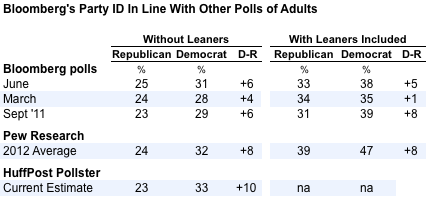
WASHINGTON -- A new Bloomberg News national poll shows President Barack Obama leading Republican challenger Mitt Romney by a surprisingly large margin of 53 to 40 percent. Could it be right?
The case for this poll being a random outlier is strong. As MSNBC host Joe Scarborough put it Wednesday morning, "Thirteen points just doesn't seem to be in line with what we've been hearing."
Other surveys conducted in recent weeks have shown a generally closer race. The HuffPost Pollster chart, based on all available public polls, gives Obama a slight lead of 46.0 to 44.7 percent. If we set aside the Bloomberg polls and also exclude others (Rasmussen Reports and Gallup) that tend to skew more for Romney, Obama's lead would expand to just over three points (47.2 to 44.1 percent). But even under those very favorable assumptions for the president, Bloomberg's June poll still stands out.
Why the difference? Bloomberg pollster J. Ann Selzer admitted that she too was surprised. "We definitely looked at our poll and said wow," she told The Huffington Post via email. "The underlying factors, however, are right in line with our March poll," which showed Obama and Romney tied at 47 percent each.
The March and June polls both used live interviewers to contact randomly selected landline and mobile phones, and both reported results for the Obama-Romney race among the roughly three-quarters of adults who said they would "definitely vote" in the 2012 general election.
The demographics of the two Bloomberg samples also appear similar, as well as roughly in line with U.S. Census estimates. If anything, Bloomberg's June sample of adults includes a slightly lower percentage of Hispanics than reported by the Census -- a difference that would tend to make the poll more Republican, not less so.
The June poll reports that 31 percent of those in its adults sample described themselves as Democrats and 25 percent as Republicans. That's a slightly higher percentage of Democrats than in its March poll, but well in line with the numbers produced by the Pew Research Center and the overall party identification average in recent polls of adults compiled by HuffPost Pollster.

Of course, like many other news organizations, Bloomberg does not share the demographics or party leanings of the "likely voters" who were asked the Obama-Romney vote question. So we have no way of knowing if the demographics or partisanship of that subgroup shifted meaningfully from March to June.
Selzer speculated that the Bloomberg poll may have "caught a moment when the wind was at Obama's back" or that an increase in Americans feeling better off led some voters "to think things are not as bad as Republicans say." But she also pointed out that Romney holds a one-point lead among the most enthusiastic voters, "so there is no sense this poll forecasts an easy stride to the finish line."
The most likely possibility is that this poll simply represents a statistical outlier. Yes, with a 3 percent margin of error, its Obama advantage of 53 to 40 percent is significantly different than the low single-digit lead suggested by the polling averages. However, that margin of error assumes a 95 percent level of confidence, which in simpler language means that one poll estimate in 20 will fall outside the margin of error by chance alone.
The spread of blue and red dots in the HuffPost Pollster chart shows that such outliers do occur at about the 1-in-20 frequency we would expect. So unless and until other polls confirm the Bloomberg result, it's best to focus on the averages and assume the Obama-Romney race remains close.
